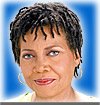
Black leaders at last declare war on AIDS and its ally, homophobia
BY MARY MITCHELL, SUN-TIMES COLUMNIST
The face of AIDS is black. That acknowledgment from black leaders at the 16th International AIDS Conference in Toronto has been a long time coming. While emphasis has been placed on the pandemic in Africa, HIV/AIDS has violently ravaged rural and urban black America. On Monday, national black leaders joined Julian Bond, the longtime chairman of the NAACP, and stepped up to declare an all-out war on AIDS in the black community.
A war on stigma.
A war on homophobia.
A war on ignorance and irresponsibility.
“The majority of new HIV infections here are black, the majority of people who die from AIDS here are black and the people most at risk of contracting this virus in the United States are black,” Bond wrote in a Monday opinion piece for the Washington Post. “AIDS is now in our house. It’s now our problem, and we must come up with solutions.”
The statistics are shocking.
•Nearly 50 percent of black gay and bisexual men in some of America’s cities are estimated to be infected with HIV.
•Black women account for nearly 70 percent of the newly infected cases.
•Black youth represent nearly 56 percent of the new AIDS cases.
•Of the 1 million people who are living with HIV/AIDS, nearly half of them are black, according to the latest statistics from the U.S. Centers for Disease Control and Prevention.
“AIDS in America today is black,” said Phill Wilson, executive director of the Black AIDS Institute and the driving force behind what’s being called a “national call to action and declaration of commitment to end the AIDS epidemic in Black America.”
The commitment was personally signed by a lineup of national black leaders that came to the conference. Included were Rep. Maxine Waters (D-Calif.); Permessa Seele, founder of the Balm in Gilead, a network of African-American churches that has been at the forefront of the disparity of health care issue; George Curry of the National Newspapers Publishers Association, and Cheryl Cooper of the National Council of Negro Women.
“We call on leaders to lead,” Wilson said at a Toronto press conference. “The AIDS story in America is mostly one of a failure to lead.”
Neither the Rev. Jesse Jackson nor Al Sharpton attended the conference, but they sent letters of support. The National Urban League dispatched a representative.
Still, the pledge was historic for two reasons: It signaled a willingness on the part of black organizations to move AIDS to the top of their agendas, and it put these organizations on the spot.
In order to accomplish the threefold goal of reducing HIV rates in black America over the next five years; to increase the percentage of African Americans who get tested and know their HIV status, and to increase access to appropriate care and treatment, black leaders will have to tackle the thorny issue of homophobia in the black community.
In a media roundtable discussion put together by Black AIDS Institute before the convention kicked off, several black men who are living with the virus challenged black journalists to begin the conversation on this subject.
“What is it that the African-American community believes about homosexuality and why?” one speaker asked. “We are having a debate about same-sex marriage -- and in my view same-sex marriage isn’t in the top 10 of our agenda. Same-sex marriage is no threat to anyone else.”
‘We’ve got to care’
Ironically, traditional marriage may now pose the biggest threat to African-American women. Actor and filmmaker Bill Duke gave roundtable participants a first look at his documentary, “Faces,” a film about the devastation of AIDS.
He was compelled to tackle the subject after his goddaughter disclosed that she was HIV-positive. She had been married 12 years. After her diagnosis, her husband admitted he had been sleeping with a man 10 of those years.
This year’s conference marked the first time the Black AIDS Institute has played a prominent role in conference programming. The group coordinated several of the sessions geared toward African-American policy makers. A standout among them was a performance by stage and TV actress Sheryl Lee Ralph.
Ralph performed two characters from her new one-woman show, “Sometimes I Cry.”
“I try to use my talent to make us know we’ve got to care. I want my daughter to have all of the information, all of the education possible about HIV/AIDS.
“In the future, I do not want to send my child into this war of life.”
We are now at the point where stigma doesn’t matter.

1 comment:
It's great that we are coming together on this but I wonder how many more supporters would have participated if we had known about the conference more than a week before hand. I live in Toronto - only steps away from an outdoor installation depicting life in an African village with Aids and yet for the weeks leading up to the grand opening I had no idea what was inside the massive tent. Poor, poor, poor advertising of such an important event and then on top of it all our own Prime Minister's indifference and failure to attend mars an otherwise great meeting of the minds.
Post a Comment